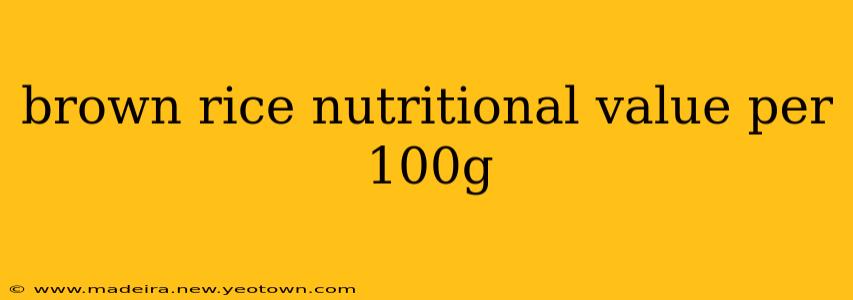Unlocking the Nutritional Powerhouse: A Deep Dive into Brown Rice's 100g Nutritional Profile
Brown rice, a whole grain marvel, has steadily climbed the ranks of health-conscious food choices. But what exactly makes it so nutritious? Let's delve into the detailed nutritional breakdown of 100 grams of this unpolished grain, exploring its benefits and answering some frequently asked questions.
Imagine a tiny, unassuming grain, packed with a surprising array of nutrients. This is brown rice, a staple in many cultures, and a powerhouse of goodness. It’s more than just a side dish; it’s a nutritional cornerstone for a balanced diet.
The Nutritional Powerhouse Unveiled: A 100g Serving of Brown Rice
A typical 100g serving of cooked brown rice boasts an impressive array of nutrients. While the exact values can vary slightly based on factors like growing conditions and rice variety, here’s a general overview:
- Calories: Approximately 111-115 calories
- Carbohydrates: Around 23-25 grams, a significant portion of which are complex carbohydrates, providing sustained energy release.
- Protein: Roughly 2.7-3 grams, contributing to muscle building and repair.
- Fat: A modest 1-2 grams, predominantly healthy unsaturated fats.
- Fiber: A substantial 2-3 grams, crucial for digestive health and promoting satiety.
- Vitamins & Minerals: Brown rice is a good source of several essential vitamins and minerals including magnesium, manganese, selenium, and various B vitamins (like thiamin, riboflavin, and niacin). These play vital roles in energy production, nerve function, and overall well-being.
What are the health benefits of brown rice?
Brown rice isn't just about the numbers; it's about the impact these nutrients have on your health. Its high fiber content aids digestion, preventing constipation and promoting gut health. The complex carbohydrates provide sustained energy, preventing energy crashes. The presence of magnesium contributes to healthy blood pressure and muscle function. The various B vitamins support nerve function and energy metabolism.
How does brown rice compare to white rice?
This is a question frequently asked by those making healthier food choices. The key difference lies in processing. White rice undergoes significant milling, removing the bran and germ, which are the parts containing most of the fiber, vitamins, and minerals. Brown rice, on the other hand, retains these valuable components, making it a far more nutrient-dense option.
Is brown rice gluten-free?
Yes, brown rice is naturally gluten-free, making it a suitable choice for individuals with celiac disease or gluten sensitivity. Always check the label to ensure there's no cross-contamination during processing, especially if buying pre-packaged mixes or prepared dishes.
How many calories are in 100g of cooked brown rice?
As mentioned earlier, a 100g serving of cooked brown rice typically contains approximately 111-115 calories. However, the calorie count can vary based on the cooking method and the specific type of brown rice used.
What are the disadvantages of eating brown rice?
While incredibly healthy, brown rice does have a few potential downsides. Some individuals might experience digestive discomfort, such as bloating or gas, initially due to its higher fiber content. This usually subsides with regular consumption as the body adjusts. Also, brown rice tends to have a shorter shelf life than white rice.
The Final Word on Brown Rice's Nutritional Power
Brown rice stands as a testament to the nutritional bounty found in whole grains. Its rich profile of vitamins, minerals, and fiber makes it a valuable addition to any balanced diet. From promoting digestive health to providing sustained energy, brown rice offers numerous benefits. By understanding its nutritional value and potential benefits, you can confidently incorporate this wholesome grain into your meals and reap its remarkable health rewards. Remember to consult with a healthcare professional or registered dietitian for personalized dietary advice.

